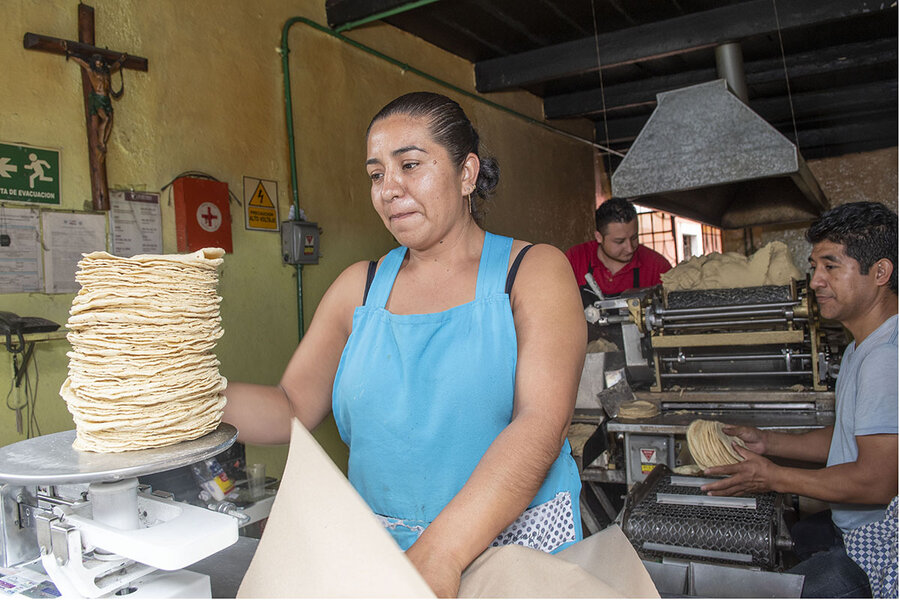Bringing dignity to Mexican food, a tortilla at a time
Loading...
I still remember the afternoon spent in Belize grinding corn to make tortillas.
A local woman had offered to teach a group of us. First, we separated dried kernels from the cob. Then, she showed us a bucket of kernels that had soaked overnight in water with dissolved lime. She washed and drained the corn, and we got to work grinding it. We passed the dough through the grinder a second time to get rid of the gritty texture. Then, the flattened balls of dough were nestled on a griddle over an open fire. It was hot, hard work.
Why We Wrote This
A story focused onAuthentic corn tortillas require time-intensive – even scientific – prep work. But for chefs who swear by them, the methods offer a way to explore foods and cultures with respect.
This process of soaking corn in alkalized water to break down the outer hull of the kernel is called nixtamalization. More Mexican chefs in the United States are reviving nixtamalization to make authentic corn tortillas, says Chef Gustavo Romero of Minneapolis. “I don’t think you can really know or understand people until you understand their culture and what they eat,” he says.
In my tortilla-making class in Belize, we asked our teacher how many tortillas she made each day for her family. “About 75, three times a day,” she said. It takes her six hours. For people used to ripping open bags of mass-produced tortillas, that was a lot to process. But to our hostess, it was simply the only and best way.
We agreed.
I still remember the afternoon spent in Belize grinding corn to make tortillas. I was staying at an ecolodge, and a gracious local woman had welcomed our group into her thatched-roof home to tutor us in this task. First, we separated dried kernels from the cob. Then, she showed us a bucket of kernels that had soaked overnight in water with dissolved lime. She washed and drained the corn, and we got to work grinding it. We passed the dough through the grinder a second time to get rid of the gritty texture. Then, the flattened balls of dough were nestled on a griddle over an open fire. It was hot, hard work.
This process of soaking corn in alkalized water to break down the outer hull of the kernel is called nixtamalization. More Mexican chefs in the United States are reviving nixtamalization to make authentic corn tortillas, says Chef Gustavo Romero of Minneapolis. “I don’t think you can really know or understand people until you understand their culture and what they eat,” he says.
Chef Romero, who runs Nixta, an artisanal tortilleria, is passionate about reviving time-honored techniques to bring a sense of dignity to Mexican food, which, he says, became synonymous with “fast” and “cheap.”
Why We Wrote This
A story focused onAuthentic corn tortillas require time-intensive – even scientific – prep work. But for chefs who swear by them, the methods offer a way to explore foods and cultures with respect.
“That’s not what our food is,” he says. “That’s not how it started.”
In ancient practices, nixtamalization was done with wood ashes, and that’s where the name comes from. Nextli (ashes) combines with tamalli (tamale) in Nahuatl, an Aztec language spoken across Mexico. Chef Romero, who uses powder from ground volcanic stone to alkalize water, says this process allows the corn to absorb more calcium and potassium, making for more nutritious tortillas. He uses 18 to 20 varieties of imported Mexican heirloom corn that yield a rainbow of white, yellow, pink, purple, and dark blue tortillas. He says it’s essential to use heirloom corn when making tortillas “the right way.” Mexican corn breaks down more easily in the nixtamalization process since it has a thinner hull, unlike the sturdy yellow corn that can withstand harsh North American winters.
In my tortilla-making class in Belize, our group managed to produce a few dozen tortillas, which we promptly ate warm, topped with sliced hard-boiled eggs and freshly made salsa. We asked our teacher how many tortillas she made each day for her family. “About 75, three times a day,” she said. It takes her six hours. For people used to ripping open bags of mass-produced tortillas, that was a lot to process. But to our hostess, it was simply the only and best way. And we agreed.









